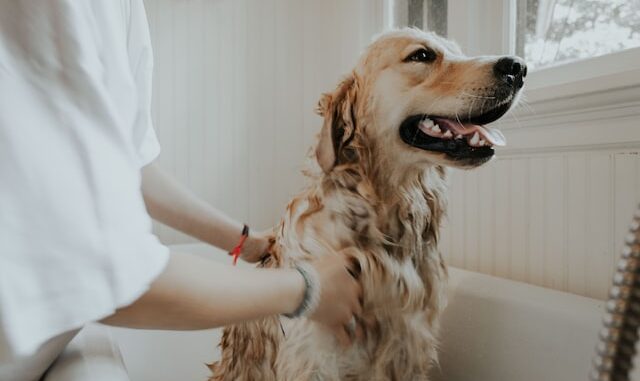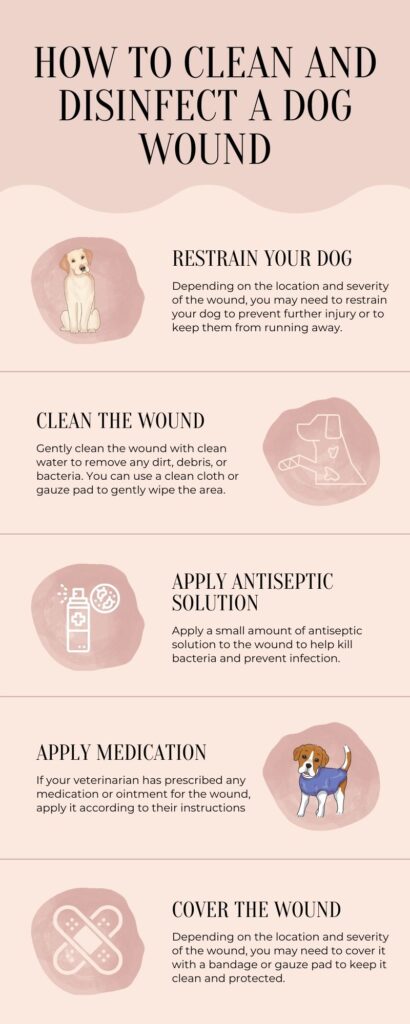
Table of Contents
Introduction
Dogs are adventurous animals and they love to play, explore and run around. Unfortunately, with all of this activity, dogs can sometimes end up with wounds that require care and attention. Proper wound care is essential for a dog’s health and well-being, as it can prevent infections, promote healing, and even save its life.
In this complete guide, we’ll cover everything you need to know about dog wound care, including how to identify wounds, how to prepare for treatment, and how to treat different types of wounds. We’ll also provide tips on how to prevent wounds from happening in the first place and when to seek professional veterinary care. Whether you’re a first-time dog owner or a seasoned pro, this guide will help you ensure that your furry friend stays healthy and happy.
Identifying Wounds in Dogs
Identifying wounds in dogs is the first step to providing proper dog wound care. Dogs can get different types of wounds, ranging from minor cuts and scrapes to more severe injuries such as puncture wounds or bites. Here are some common types of wounds that you might come across:
- Abrasions: These are surface wounds caused by scraping or rubbing against a rough surface.
- Lacerations: These are deeper cuts that can be caused by sharp objects, such as glass or metal.
- Puncture wounds: These wounds are caused by sharp objects, such as teeth or claws, piercing the skin.
- Bites: Dogs can get bitten by other animals, such as other dogs or wild animals.
- Burns: Burns can be caused by hot surfaces or chemicals.
If you notice any of the following signs, your dog may have a wound that needs attention:
- Bleeding
- Swelling
- Redness or inflammation
- Pain or discomfort
- Limping or favoring a limb
- Loss of appetite or lethargy
If you suspect that your dog has a wound, it’s important to examine the area carefully and seek veterinary attention if necessary. Prompt identification and treatment can help prevent complications and speed up healing.
Preparing for Dog Wound Care
Before you start treating your dog’s wound, it’s important to make sure you have everything you need to provide proper care. Here are some supplies and tools you may need:
- Clean water: You’ll need water to clean the wound and rinse away any debris.
- Antiseptic solution: An antiseptic solution can help kill bacteria and prevent infection. Your veterinarian can recommend a safe and effective antiseptic solution for your dog.
- Gauze pads or clean cloths: These can be used to clean the wound and apply any medications or ointments.
- Medical gloves: Wearing gloves can help prevent the spread of infection and protect your hands from any harsh chemicals.
- Elizabethan collar (e-collar): An e-collar can help prevent your dog from licking or biting the wound, which can delay healing and increase the risk of infection.
In addition to gathering supplies, there are some precautions you should take before beginning treatment. Here are a few tips:
- Stay calm: Dogs can sense our emotions, so staying calm and relaxed can help keep your dog calm as well.
- Restrain your dog: Depending on the location and severity of the wound, your dog may need to be restrained to prevent further injury or to keep them from running away.
- Trim hair: If your dog has long hair around the wound, it may need to be trimmed to keep the area clean and dry.
By preparing ahead of time and taking these precautions, you can make sure that you’re ready to provide effective dog wound care.
How to Clean and Disinfect a Dog Wound

Cleaning and disinfecting a dog wound is an important step in the healing process. Here’s how to do it:
- Restrain your dog: Depending on the location and severity of the wound, you may need to restrain your dog to prevent further injury or to keep them from running away.
- Clean the wound: Gently clean the wound with clean water to remove any dirt, debris, or bacteria. You can use a clean cloth or gauze pad to gently wipe the area.
- Apply antiseptic solution: Apply a small amount of antiseptic solution to the wound to help kill bacteria and prevent infection. Your veterinarian can recommend a safe and effective antiseptic solution for your dog.
- Apply medication: If your veterinarian has prescribed any medication or ointment for the wound, apply it according to their instructions.
- Cover the wound: Depending on the location and severity of the wound, you may need to cover it with a bandage or gauze pad to keep it clean and protected. Your veterinarian can provide guidance on the best way to cover the wound.
- Monitor the wound: Check the wound regularly to make sure it’s healing properly. Look for any signs of infection, such as redness, swelling, or discharge. If you notice any signs of infection, contact your veterinarian right away.
It’s important to note that cleaning and disinfecting a wound can be painful for your dog. To help minimize discomfort, you can use a gentle touch and offer treats or praise to help distract your dog. You can also talk to your veterinarian about pain management options if your dog is experiencing significant discomfort.
Treating Common Dog Wounds
Different types of wounds require different treatments. Here’s how to treat some common types of wounds in dogs:
- Abrasions: Clean the wound with water and an antiseptic solution. Cover the wound with a sterile dressing or bandage, and monitor it for signs of infection.
- Lacerations: If the laceration is deep or bleeding heavily, seek veterinary attention immediately. If the wound is shallow, clean it with water and an antiseptic solution. Apply pressure to the wound with a clean cloth to stop any bleeding. Cover the wound with a sterile dressing or bandage, and monitor it for signs of infection.
- Puncture wounds: Puncture wounds can be deep and difficult to clean, and may require veterinary attention. If the wound is small and not bleeding heavily, clean it with water and an antiseptic solution. Monitor the wound for signs of infection, and seek veterinary attention if necessary.
- Bites: If your dog has been bitten by another animal, seek veterinary attention immediately. Bites can cause serious infections and may require antibiotics or other medical treatments.
- Burns: Burns can be caused by hot surfaces or chemicals. Flush the burn with cool water for at least 20 minutes. Apply a cool, damp compress to the burn, and seek veterinary attention if necessary.
Remember, it’s always best to seek veterinary attention if you’re unsure how to treat your dog’s wound or if you suspect that the wound is serious. Prompt and proper treatment can help prevent complications and promote healing.
Preventing Dog Wounds
Preventing wounds in your dog is key to keeping them healthy and happy. Here are some tips for preventing dog wounds:
- Keep your dog on a leash: Keeping your dog on a leash can prevent them from running into dangerous situations or getting into fights with other animals.
- Provide a safe environment: Make sure your dog’s environment is safe and secure. Keep hazardous items, such as sharp objects or toxic chemicals, out of reach.
- Supervise your dog: Keep an eye on your dog at all times, especially when they’re playing with other animals or children.
- Use protective gear: If your dog is engaged in activities that could lead to injuries, such as hunting or hiking, consider using protective gear, such as a harness or boots.
- Maintain your dog’s health: Keeping your dog healthy can help prevent wounds and infections. Make sure they receive regular veterinary care, including vaccinations and parasite prevention.
By taking these steps, you can help keep your dog safe and prevent unnecessary injuries. If you have any concerns about your dog’s health or safety, talk to your veterinarian for guidance.
When to Seek Veterinary Care
While some minor wounds can be treated at home, there are times when you should seek veterinary care for your dog. Here are some situations when you should seek veterinary attention:
- The wound is deep or bleeding heavily: Deep or heavily bleeding wounds can be serious and require immediate veterinary attention.
- The wound is located near the eyes, ears, or mouth: Wounds in these areas can be difficult to treat and may require veterinary attention.
- The wound is infected: Signs of infection include redness, swelling, warmth, discharge, and odor. Infected wounds require veterinary attention and may require antibiotics or other medical treatments.
- Your dog is showing signs of pain or discomfort: If your dog seems to be in pain or is showing signs of discomfort, seek veterinary attention.
- The wound is not healing: If the wound is not healing or is getting worse, seek veterinary attention.
- Your dog has been bitten by another animal: Bite wounds can be serious and require veterinary attention. Your dog may need antibiotics or other medical treatments to prevent infection.
Remember, prompt veterinary attention can help prevent complications and promote healing. If you’re unsure whether your dog needs veterinary care, it’s always best to err on the side of caution and seek advice from your veterinarian.
You can cover your veterinary bill with your pet insurance. You can read reviews of top pet insurance companies here.
Conclusion
Caring for your dog’s wounds is an important part of keeping them healthy and happy. By following the steps outlined in this guide to dog wound care, you can clean and disinfect your dog’s wounds, treat common types of wounds, and prevent future injuries. Remember to seek veterinary attention if you’re unsure how to treat a wound or if you suspect that the wound is serious. With proper care and attention, you can help your dog heal and thrive.

Leave a Reply